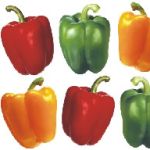| Variations: |
Anaheim
Is a New Mexican pod type, early, with tapering, pointed, mildly pungent, dark green fruits. 15-20cm (6-8in) long and up to 5cm (2in) wide, turning scarlet when ripe. Excellent for stuffing. Dried and ground into paprika when ripe.
Height: 60cm (24in)
Width: 38cm (15in) |
Ancho
Has medium hot, heart-shaped, thin-walled, fruits, 8-15cm (3-6in) long and 7cm (3in) wide, known as poblanos; used in Mexian mole sauces and chiles rellenos (stuffed chilis).
|
Cascabel
Has moderately hot, thin-walled, rounded, shiny fruits that ripen brown with a fruity flavor. Dried whole and often used with seafood.
|
Cayenne
Is a pod type originating in Cayenne, French Guiana, with highly pungent, slender, often crescent-shaped pods, 13-25cm (5-10in) long, and 1-2.5cm (3/8-1in) wide, that may be green or yellow, ripening red. Commercially used for hot sauces and flaked chili pepper.
Height: 75-90cm (2½-3ft) |
Chiltepin syn. C. annuum var. glabriusculum, C. annuum var. minimum. Chile piquín
(Bird Pepper)
Bears fiercely hot, bullet-shaped fruits, up to 2.5cm (1in) long and 1cm (3/8in)wide. Often harvested from the wild in Mexico
Height: 2m (6ft)
Width: 1-1.2m (3-4ft) |
Arbol
Forms and erect, tree-like plant, bearing narrow fruits, 5-7cm (2-3in) long, with a smoky flavor, which are usually ground into powder.
|
Guajillo
Has moderately hot, thin-walled, translucent, burgundy fruits, 13cm (5in) long, and tapering from 3.5cm (1 3/8in) wide. Fruity flave is ideal for red enchilata sauce.
Height: 90cm (3ft)
|
Jalapeño
Is a compact Mexican cultivar with usually vrey pungent, thick-walled, cylindrical, green fruits, 6-10cm (2½-4in) long, that ripen red and typically develop crackes or netting, called corkiness. A main ingredient in salsa. Mature red fruits are smoke-dried as Chipolte
Height: 60cm (24in)
Width: 45cm (18in) |
Mirasol
Has a spreading, much-branched habit and ornamental clusters of erect, pointed, red fruits, 8-10cm (3-4in) long, and 1-2cm (3/8-¾in) wide. Dried for chili powder.
Height: 1.2m (4ft)
Width: 1.2m (4ft)
|
Mulato
Is a similar pod type to ancho, with late-maturing, tapering, blunt-ended fruits 10-15cm (6-12in) long, and 7cm (3in) wide that ripen brown and have a moderately hot, chocolate-like flavor. Used for stuffing when fresh, or dried for mole sauces
Height: 90cm (3ft)
Width: 1.2m (4ft) |
Pasilla
Is a vigorous, late-maturing type with cylindrical, moderately hot, dark green pods, 15-30cm (6-12in) long and up to 2.5cm (1in) wide, that ripen brown and have a smoky, raisin-like flavor. Green fruits, known as chilaca, are eaten raw or cooked; mature fruits are dried for mole sauces.
|
Purple Tiger
Is compact, with foliage variegated white and purple, and small, extremely pungent, tear-shaped fruits that ripen through red to deep purple.
Height: 70cm (28in)
Width: 50cm (20in)
|
Serrano
Is an upland Mexican pod type with hairy leaves and cylindrical fruits, 5-13cm (2-5in) long, which ripen red, orange, yellow, or brown. Good for salsa known as pico de gallo.
Height: 90cm (3ft)
Width: 45cm (18in) |
Thai Hot
Is an Asian pod type, with a compact habit and prolific, highly pungent, cone-shaped fruits, 2.5-6cm (1-2½in) long, that ripen red and are used fresh or dried in Thai and other Asian dishes.
|
|
| NOTE: |
Certain pod types ahve names that are not strictly cultivar names, but are often (as here) treated as such. Most pod types have a number of cultivars. For example, Jalapeño is a pod type that originated in the town of Jalapa, Mexico. Cultivars of the jalapeño type include 'Nu Mex Primavera', and 'Jumbo Jalapeño'.
| Hardiness: |
Min. 4-21°C (39-70°F) |
| Parts Used: |
Fruits |
| Properties: |
Pungent-fruited cultivars have tonic and antiseptic effects, stimulate the circulatory and digestive systems, and increase perspiration. They also irritate the tissues, increasing blood supply to the area, and reducing sensitivity to pain. |
| Medicinal Uses: |
Internally for the cold stage of fevers, debility in convalescence or old age, varicose veins, poor circulation, asthma, and digestive problems. Externally for sprains, arthritis, unbroken chilblains, neuralgia, lumbago, and pleurisy, and combined with Commiphora myrrha (see myrrh) as a gargle for laryngitis. Pungent-fruited peppers are important as a gastrointenstinal detoxicant and food preservative in the tropics. |
| Culinary Uses: |
Both pungent-fruited and sweet-fruited cultivars are used ripe or unripe, fresh or dried, as vegetables (raw or cooked), stuffed, and in curries, pickles and chutneys, in many parts of the world, especially in S and C America, Mexico, India, and SE Asia. Ripe fruits are dried to make cayenne, chili powder, or paprika. Pungent-fruited peppers may cause painful inflammation in excess, or other accidental contact with eyes or broken skin. |
| Warning: |
Capsicum oleo-resin is subject to legal restrictions in some countries. |
| Bibliography: |
Encylopedia of Herbs by Deni Brown Copyright ©: 1995, 2001 Dorling Kindersley Limited pp 153-155
|
|
